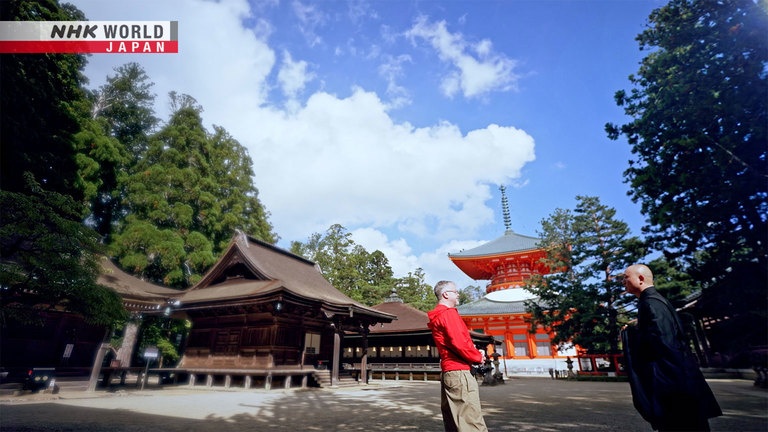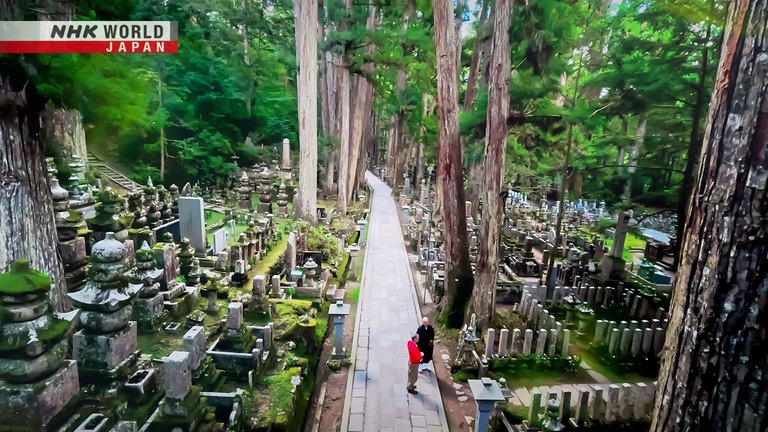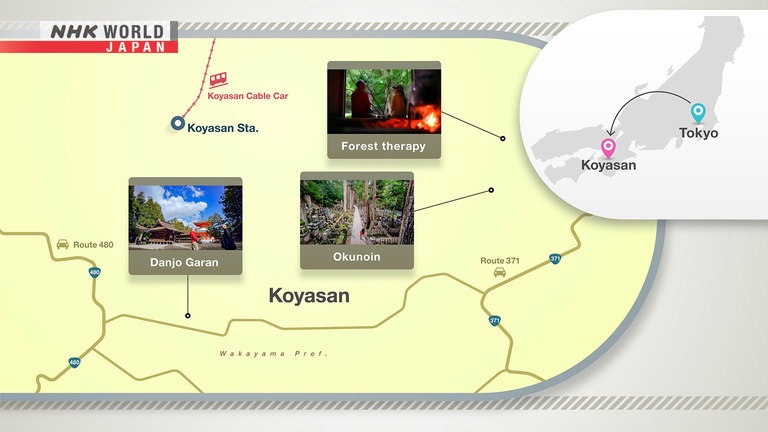Koyasan: In Pursuit of Enlightenment
Koyasan, in the mountains of Wakayama Prefecture, is a sacred site of Shingon Buddhism. It was founded by the visionary monk, Kukai, about 1,200 years ago. Pilgrims and tourists alike stay in shukubo temple lodgings, some of which even feature luxury rooms. Visitors enjoy shojin vegetarian cuisine, meditation sessions and walks through the forests, as well as a famous cemetery. On this journey, British photographer Alfie Goodrich explores the tangible, and intangible, treasures of mysterious Koyasan.
Danjo Garan

This complex, the first Kukai established in Koyasan, has 19 structures. They include Koyasan’s main temple, called the Kondo Hall, and the Konpon Daito pagoda—a symbol of Koyasan.
Okunoin

Okunoin is home to the mausoleum of Kukai. 200,000 memorial towers for noted warlords and graves stretch for two kilometers along a cedar tree-studded path.
Koyasan Forest Therapy

Sacred Koyasan is set in deep woodland. Koyasan Forest Therapy is a program that allows participants to enjoy the sights, smells, sounds and textures of this rich nature with their five senses.
Access

It takes about five hours to reach Koyasan from Tokyo, via Shinkansen to Shin-Osaka with transfers to local lines and the cable car.
Transcript
"Journeys in Japan"
My name is, Alfie, photographer.
I came here because there is a religious city in Japan.
But I had no idea it was on top of a mountain.
Koyasan.
The universe of the Buddhist sage, Kukai,
a monk who meditated on truth and joy,
and believed enlightenment attainable in anyone's lifetime.
On "Journeys in Japan,"
our ascent plunges us 1,200 years into the past,
yet pulls us into the present and future.
Koyasan, Wakayama
In Pursuit of Enlightenment
Koyasan is hidden deep in the mountains of northern Wakayama,
400 kilometers from Tokyo.
(Daimon)
I've come to Koyasan, one of the sacred places for Japanese Buddhism.
And at the entrance, there's this large gate suggesting that from here on,
we're about to enter another world.
Beyond the gate,
Koyasan and its 117 temples stretch out.
Kongobuji is the head temple of the Koyasan Shingon esoteric school.
(Kondo Hall)
Inaba Jijyun is a priest here.
Alfie, you know who founded Koyasan, don't you?
I've heard it's the Buddhist monk, Kukai.
Known posthumously as Kobo Daishi, or Master,
he began making his mark as a monk when he voyaged to China
to study esoteric Shingon Buddhism, called Mikkyo in Japan.
Appointed as a successor of the school,
he returned home some two years later.
Soon after, Kukai founded the first Shingon school in Japan
in a site that called to him, Koyasan.
Danjo Garan is Kukai's first complex in Koyasan,
and consists of many sacred buildings.
The Konpon Daito pagoda is one of its most important.
Please come in.
Oh wow, how divine.
The pagoda interior has a rare three-dimensional mandala
featuring the Dainichi Nyorai,
a main object of worship in the Shingon school,
surrounded by other statues and pillars.
There are two important scriptures in the Shingon school,
Dainichikyo and Kongochogyo.
Based on them, Kukai visualized the truth of the universe
in Kongokai-mandara and Taizo-mandara.
He then transposed his visions in 3-D Buddhist statues.
The state of enlightenment and the essence of the teachings,
I wonder if it's possible to understand that.
This is Okunoin.
For two kilometers, we will pass graves and memorial towers.
Not just graves, but impressive memorial markers
were built to console the souls of the deceased.
About how many are commemorated here?
Counting what's visible, about 200,000.
Many more are underground.
These memorials have been placed for over 1200 years.
The memorials are dedicated to warlords and other individuals
who have left their mark on Japanese history.
And...
Alfie, please look here.
What are they?
"Isseki-gorin-to." Centuries ago,
ordinary people carved stones into five-tiered stupa and placed them like this.
Koyasan has accepted everyone in its history.
This is the grave of feudal warlord, Akechi Mitsuhide.
He is infamous as the warlord who killed the powerful Oda Nobunaga.
Akechi Mitsuhide betrayed his master,
the legendary warlord Oda Nobunaga, in Kyoto in 1582.
In death, Akechi became Oda's sworn enemy.
Oda Nobunaga is commemorated here in Koyasan, too.
The enemies are resting in the same place, Okunoin.
Two enemies buried in the same place. How interesting.
Actually, Kukai is alive at the end of the pilgrimage path.
His wish is that people transcend status and embrace inclusivity.
He accepts all here.
So, Kukai is still here?
He is in the mausoleum called Gobyo over there.
Kukai has been in "eternal meditation" here since the year 835,
praying for people's happiness.
Meditation requires some sustenance,
so monks deliver meals to Kukai twice a day.
People really think that Kukai is still here,
and that's the deep faith which remains unchanged.
We have a tour where you can enjoy the nature of Koyasan.
- Would you like to join me?
- I'd love to. That sounds great.
Okay, let's go.
Tanaka Atsuyo is a "forest therapy" guide.
And for her practice, Koyasan is sublime.
Forest therapy is forest bathing in which participants can walk through,
immerse themselves in the beautiful nature.
Let's just stop.
Now listen.
Nice.
It's nice just to stop and
listen because the water is an incredible sound.
Very refreshing.
And maybe some little birds,
leaves
and the wind.
Alfie, don't you smell something sweet?
- Yes, I do.
- What do you think it is?
I have no idea. What is it?
- Leaves?
- Just smell this leaf.
Wow. Very sweet like cream soda or maple syrup?
It is from this "katsura" tree.
The fallen leaves ferment, and give off a sweet aroma.
Very nice.
So I have something for you.
For now, why don't you take a rest?
Okay.
Alfie-san, it's ready.
Okay.
Here you are.
Wow.
- Alfie-san, here's your coffee.
- Thank you.
That's really good.
So, how was today?
It's been amazing. Thank you so much.
(Ekoin)
Hello, nice to meet you.
Kondo Sesshu is the chief priest here.
This is a temple?
Yes, a "shukubo," offering overnight stays.
Shukubo originally only accommodated monks and worshippers.
But that all changed some time ago
when their doors slid open to tourists, too.
Where have you come from?
So, we came from Italy.
What brought you to this place?
A different experience in my life.
Something new and something deep.
We are into meditation as well,
and into, let's say, retirement and switching off, charging batteries.
This way please.
Standard rooms are divided by "fusuma" sliding partitions,
and guests sleep on futons.
But this shukubo actually has...
This is our suite room.
This doesn't look like a temple. It's like a five-star hotel.
What a wonderful aroma.
It's the "hinoki" cypress.
Amazing.
This is a semi open-air private bath.
Amazing.
The room also features contemporary art,
and sumptuous beds.
Guests can also learn a little of the teachings of the Shingon school.
...bend your left leg.
This meditation style is called Ajikan, which involves breathing.
...your thumbs.
Put your thumb together like this.
Just a short experience of this meditation,
but I feel more focused or I just... Like, now I have a
tool to focus every day, relaxed and calm.
Dinner.
This must be "shojin ryori."
The cuisine absent of meat, fish, dairy
and ingredients with strong aromas.
It is based on the Buddhist principle of not killing.
Two tofu dishes are essential to shojin.
"Goma-dofu," which actually has no soybean,
but is named for the form, and main ingredient of sesame.
Grinding the sesame was traditionally the meditative work of the monks.
The other, "koya-dofu," was a delicious accident.
One frigid winter, some tofu froze over.
When thawed and cooked, it tasted different but also very good.
Later, koya-dofu took off throughout the country,
simmered in slightly sweetened broth.
Let's try this koya-dofu first.
The tofu is a little crunchy, but the main thing is that
the broth seeps out of it. It's like a sponge full of tasty soup.
Amazing.
Okay, goma-dofu.
Oh, wow.
Its rich sesame flavor, very smooth.
Because it's sat in the sauce,
the last flavor you get is the sauce,
which is like the perfect end to eating the tofu.
It's beautiful.
So it's a really big group, and it's all foreigners
from so many different countries. It doesn't feel like Japan at all.
Okay, we're in Okunoin on the night tour, walking
through this area where there's a bunch of graves and forest.
So yeah, typically, the people who are staying at the temples
overnight come on the tour.
Can you see this small temple?
There is a famous Buddha.
His name is Sweaty Buddha.
When you are suffering, when you have pain,
you sweat often when you're in pain.
Pray to this Buddha,
and then he's going to take pain away from you.
I absolutely loved it. I thought it was really quite beautiful.
And yeah, it's really interesting kind of
what cemeteries can teach you about life,
and I thought that was kind of the most exciting thing.
Definitely more mysterious, but definitely a lot more peaceful
than during the daytime.
Well, an amazing spiritual
and a little bit mysterious evening in this beautiful location at night.
And now I'm going to go back to that gorgeous temple
and have a sleep and a nice bath.
So, good night.
(Nanin)
The Goma fire ritual, key in Shingon.
Kukai imported this rite from China.
This ritual was originally to burn out everything
including our suffering so that our wishes will be granted.
Our world is not a competitive world.
So, your level of intelligence does not matter.
What's important is to make steady efforts every day.
In Koyasan, a novice monk is called Ajari.
Hello, are you an Ajari monk?
No, I'm still a trainee.
Kerem Saglamtunc is from Turkey's capital, Ankara.
He is in training here at Yochiin temple.
So, this is my home temple.
Yeah, it's beautiful.
I thought that most Turkish people are Muslims. No?
Yes. On paper, it's like 99%.
And I think you can put all Turkish Buddhists into a small room
and we'll all fit there, basically.
After converting to Buddhism nine years ago at the age of 21,
he set out to become a monk.
So Kerem, why choose Koyasan?
So I came to Japan because I was studying Japanese at university in France,
and Koyasan specifically, because I was interested in Shingon.
I had studied it as I was studying Buddhism at the same time.
And then I was sort of introduced here to this temple.
And what was it about Shingon and Kukai that attracted your interest?
So... Well, Shingon has a very broad outlook
in its teachings, which I really like.
And, well, Kukai, you know, he studied foreign languages.
I studied foreign languages.
And he questions life when he was in university.
I had that kind of experience as well.
So I thought this is someone I can really relate to. So
that attracted me to his teachings.
His temple is also a shukubo.
So I have some work to do here, so please excuse me for a moment.
So you're helping with the people who stay here?
Yes. So, making rooms and, you know, cleaning them,
and then serving the customers who come here. That's also...
All that, I think, can be included as part of one's spiritual practice.
So if you manage to do that, you know,
it becomes something other than just like a business thing.
So yeah, it teaches you a lot of small details
which then can actually have an impact in your life.
Aratano Koei of Yochiin is mentoring Kerem.
I am only 26 years old.
Although I'm Ajari, I am not qualified to teach.
I'm a monk just like Kerem, but with a little more experience.
So, why did you take on Kerem?
I can relate to him. He may have difficulty in adjusting
to life here as a non-Japanese, but he is working very hard.
I hope to spread the teachings of the Shingon school to the world.
So, I'd like to support Kerem so that he too can become Ajari.
I'm very grateful to be here in this temple.
Our head priest, as you said, is quite young.
But thanks to that, it actually creates a very special environment.
This is a good temple, and that's...
So, thank you for all your help.
So here we are.
So this is Danjo Garan,
the first temple complex that Kukai opened.
Yes. This is, you know, one of the central places on Koyasan,
and I really like coming here. I think you can feel
kind of like a closeness to Kukai here. So it's very nice.
So Koyasan now, but what about the future?
So I don't know what the future will bring, or where I will be.
But I would like to become able to teach Shingon in the future
and have a place where I can open it up and
transmit it to other foreigners.
But before that, I have a lot more study and practice to do,
so that's my focus right now.
That's a great idea.
For over 1,200 years,
the people of Koyasan remained loyal to the faith of their ancestors.
And moreover, it's a place with many sights to see.
Koyasan was not the closed-off place
one might imagine from the word "religious."
Rather, it was open and welcoming to all people,
including foreigners.
I felt this is because the people of Koyasan
not only want to preserve their unique culture and history,
but also want to pass it on.
This is also because of the progressive
and open-minded Kukai.
To fully enjoy such a Koyasan and be part of it
has been an invaluable experience for me,
less of a destination, more perhaps the start of a richer journey,
one that starts right now with me taking a few more pictures.
It takes about five hours to reach Koyasan
from Tokyo via Shinkansen to Shin-Osaka,
with transfers to local lines,
and then cable car.